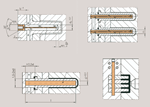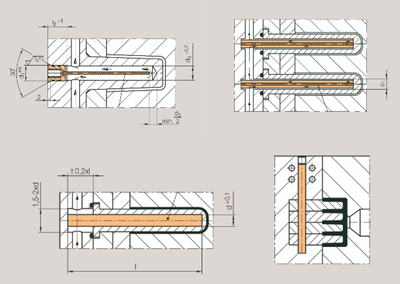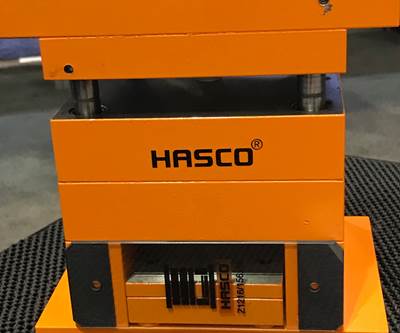Color change comparison between conventionally-made inserts and inserts made using patented shadow-free technology. Source (All Images) I Hasco
Metal 3D printing is helping to create better designs for hot runner manifolds. Not only is it making complex melt flow channel designs possible, but this same process also shortens lead times via fewer R&D iterations and evolves projects much faster, enabling upfront cost savings.
We are talking about attaching 3D printed inserts to a conventionally machined hot runner manifold base block. Conventional machining is used in areas easily manufactured. Then those areas are combined with 3D printed inserts to create a hot runner system that moldmakers can adjust “on the fly” and within days, not weeks or months.
Why would a moldmaker consider such a manifold system? Because a system manufactured this way can perform both valve gate and color changes without the unsightly flow shadows created when melt goes around the valve pin. This type of hybrid hot runner manifold system also offers closer system pitch centerlines between cavities within the hot runner manifold design, which is a big cost saving, as less steel is required for the overall project.
Almost any plastics industry sector can use this manifold system. Automotive lighting and caps and closures projects have experienced the most success. For example, a customer seeking improved molding of a valve gate lens part experienced a reduced risk of burned material traveling into the lens by making these changes to the manifold system, yielding crystal clear parts.
This type of hybrid hot runner manifold system also offers closer system pitch centerlines between cavities within the hot runner manifold design, which is a big cost saving, as less steel is required for the overall project.
It is common for a valve gate system to be inefficient with color changes compared to a conventional open-flow system. The main reason is the unfavorable flows and vortices that form on the side opposite of the valve gate needle versus the needle valve side that is exposed to the direct material flow. This condition does not allow new material to replace the old material, which then remains in the “shadow” of the needle valve pin for many cycles.
This needle shadow causes similar problems when processing a thermally unstable material, such as PPA, PA, ABS and PC. If the material stays in the poorly flushed area for too long, it breaks down. This broken down material is then slowly carried away with each cycle and shows up as burn marks or contamination in the molded part.

A 3D printed manifold has separate floating 3D printed modules attached and screwed to the conventionally machined manifold, offering more options for center-to-center distances.
3D Printed Shadow Solution
Now, there is a metal 3D printed manifold that can address this challenge. Patented shadow-free technology permits faster color changes with most materials by using valve gate systems that combine the use of modular valve gate nozzles that have various tip designs with a 3D printed screwed-on manifold.
This 3D printed manifold has separate floating 3D printed modules that are attached and screwed to the conventionally machined manifold. This process offers more options for center-to-center distances by creating spacing between valve gate drop locations on cavity placement.
Moreover, the use of 3D printing was able to produce the melt flow in the manifold in a way that conventional machining could never have, enabling the melt flow to avoid the blind spot behind a valve needle pin and eliminating the flow shadows in the valve gate system. This also allowed up to 70% faster color changes in the hot runner system compared to conventional manifold designs.

Fluid-like materials can flow around a cylindrical obstacle and form vortices that trap material on the downstream side of the channel. This causes color change failure.
One challenge is when fluid-like materials flow around a cylindrical obstacle, forming vortices and trapping material on the downstream side of the channel; this prevents the material from being exchanged in subsequent cycles and causes color change failure. To avoid this failure, the 3D printed manifold melt channel is divided and merged at the point where the valve stem enters the melt channel, removing any needle shadow and rinsing the needle valve better.

A 3D printed manifold melt channel divided and merged at the point where the valve stem enters the melt channel will avoid color change failure.
Test Results
Testing using a split hot runner (to remove the frozen melt channel for viewing and research) was completed in a hot runner system with one cavity side equipped with a standard valve gate system and the other cavity side equipped with a variant of the 3D printed manifold system (see opening image).
A color change from black to white ABS material was performed and the injection unit was purged during the change. The hot runner experienced pure white material in the first cycle after the color change. After just four shot cycles, the side equipped with the 3D printed manifold showed no deposits forming around the valve pin stem. The valve pin entry was completely clean after 24 shot cycles. Testing revealed that the estimated color change in a hot runner system can be completed 3-4 times faster while eliminating the needle shadow, and that the use of 3D printed metal inserts can ease manufacturing and help reduce system failures in the injection molding process. The color change time savings equaled yet one more costs savings benefit for the project’s long-term cost.
Related Content
Fundamentals of Designing the Optimal Cooling System
The right mold components can help improve mold cooling and thereby produce higher-quality parts.
Read MoreMachining Center Spindles: What You Need to Know
Why and how to research spindle technology before purchasing a machining center.
Read MoreThe Ins and Outs of Hot Runner Temperature Control
A training checklist that explains the why and how of proper hot runner temperature control and system management.
Read MoreRead Next
Fundamentals of Designing the Optimal Cooling System
The right mold components can help improve mold cooling and thereby produce higher-quality parts.
Read MoreHow to Machine and Seal Metric Cooling Line Threads
Understanding the machining of British standard pipe parallel (BSPP) and British standard pipe taper (BSPT) straight threads helps identify why a cooling plug may not be sealing correctly.
Read MoreThinking Big and Easy
It’s what's between the platens that matters, says Hasco Engineering Manager Brenda Clark at NPE2018. “It’s all about the precise amount of space required to get the product produced in the minimum amount of mold base, yet with the best quality and substantial steel to improve part quality.”
Read More























